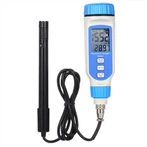Soldering iron welding skills and steps
(1) Pre-welding treatment steps
Before soldering, the component pins or the soldering parts of the circuit board should be processed. Generally, there are three steps of "scraping", "plating" and "testing":
"Scraping": It is to clean the welding part before welding. Generally, the tools used are a knife and fine sandpaper to clean the pins of the integrated circuit and the printed circuit board to remove the dirt on them. After cleaning, it is generally necessary to apply flux to the components to be removed.
"Plating": It is tin plating on the scraped components. The specific method is to dip the rosin alcohol solution and apply it on the scraped component welding parts, then press the hot soldering iron head with tin on it, and turn the components to evenly coat a thin layer of tin layer.
"Testing": It is to use a multimeter to test whether all tinned components are of reliable quality. If there are unreliable or damaged components, they should be replaced with components of the same specification.
(2) Welding steps
After the pre-welding treatment is done, the formal welding can be carried out.
Different soldering objects require different working temperatures of the soldering iron. When judging the temperature of the soldering iron tip, you can touch the soldering iron to the rosin. If there is a "squeak" sound, it means that the temperature is appropriate; if there is no sound, but the rosin can barely melt, it means that the temperature is too low; When the rosin smokes a lot, it means that the temperature is too high.
Generally speaking, there are three main steps in welding:
(1) Melt a small amount of solder and rosin on the tip of the soldering iron, and align the tip of the soldering iron and the solder wire at the solder joint at the same time.
(2) Before the flux on the tip of the soldering iron has evaporated, touch the tip of the soldering iron and the solder wire to the solder joint at the same time, and start to melt the solder.
(3) When the solder infiltrates the entire solder joint, remove the soldering iron tip and solder wire at the same time.
The welding process is generally suitable for 2 to 3 seconds. When soldering integrated circuits, the amount of solder and flux should be strictly controlled. In order to avoid damage to the integrated circuit due to poor insulation of the electric soldering iron or the induced voltage of the internal heater to the shell, in practical applications, the method of unplugging the power plug of the electric soldering iron is often used to solder while it is hot.
False Welding of Electric Soldering Iron and Its Prevention
When welding, it should be ensured that each solder joint is firmly welded and in good contact. The tin joints should be bright, smooth and free of burrs, and the amount of tin should be moderate. The tin and the object to be welded are firmly fused, and there should be no false welding. The so-called false welding means that only a small amount of tin is welded at the solder joint, resulting in poor contact and intermittent connection. In order to avoid false welding, the following points should be paid attention to:
(1) Ensure that the metal surface is clean
If there are rust, dirt or oxides on the surface of the weldment and solder joints, it should be scraped or sanded with a knife before welding until the bright metal is exposed, and then the surface of the weldment or solder joints can be tinned.
(2) Master the temperature
In order to make the temperature appropriate, an electric soldering iron with appropriate power should be selected according to the size of the components, and attention should be paid to the heating time. If you use a low-power electric soldering iron to weld large components or weld the ground wire on the metal base plate, it is easy to form a virtual weld.
When the tip of the soldering iron is pressed on the soldering place with solder, if there is no or little solder left on the soldered part after removing the soldering iron, it means that the heating time is too short, the temperature is not enough or the soldered object is too dirty; If the solder flows down before the soldering iron, it means that the heating time is too long and the temperature is too high (3) Appropriate amount of tin
Determine the amount of tin dipped by the soldering iron according to the size of the required solder joint, so that the solder is enough to cover the object to be soldered and form a smooth solder joint of appropriate size. If the tin is not enough at one time, it can be added again, but the soldering iron must be removed after the previous tin is melted together.
(4) Select the appropriate flux
The function of the flux is to improve the fluidity of the solder, prevent the oxidation of the soldering surface, and play a role of fluxing and protection. When soldering electronic components, solder paste should be avoided as much as possible. A better flux is rosin alcohol solution. When welding, just drop a little on the place to be welded.






